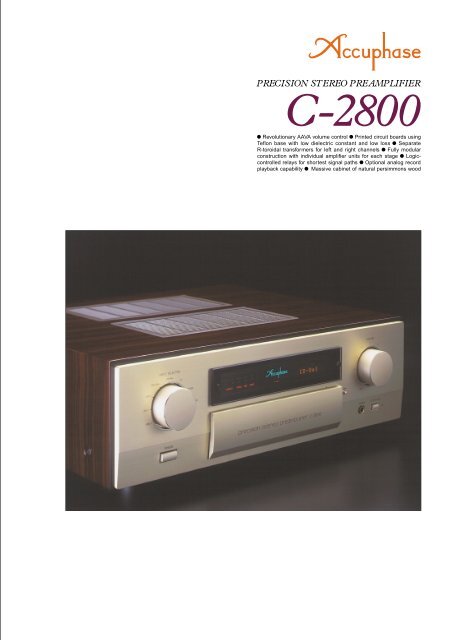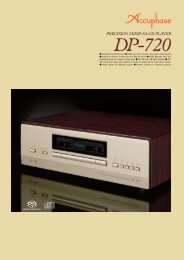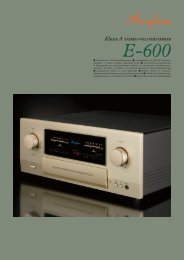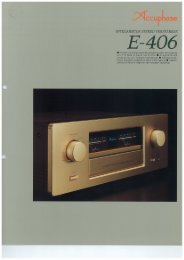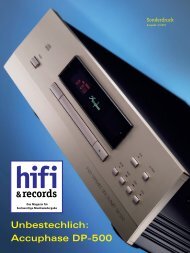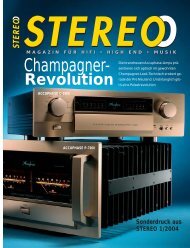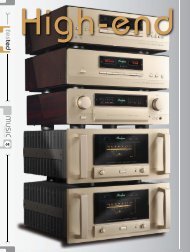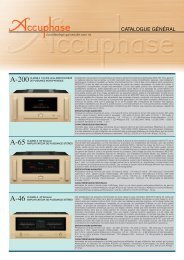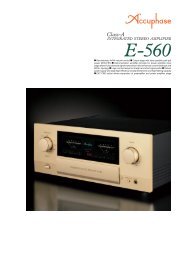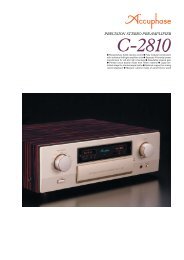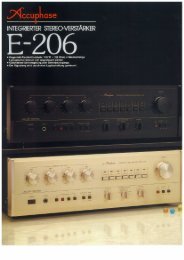m Revolutionary AAVA volume control m Printed circuit ... - Accuphase
m Revolutionary AAVA volume control m Printed circuit ... - Accuphase
m Revolutionary AAVA volume control m Printed circuit ... - Accuphase
Create successful ePaper yourself
Turn your PDF publications into a flip-book with our unique Google optimized e-Paper software.
m <strong>Revolutionary</strong> <strong>AAVA</strong> <strong>volume</strong> <strong>control</strong> m <strong>Printed</strong> <strong>circuit</strong> boards using<br />
Teflon base with low dielectric constant and low loss m Separate<br />
R-toroidal transformers for left and right channels m Fully modular<br />
construction with individual amplifier units for each stage m Logic<strong>control</strong>led<br />
relays for shortest signal paths m Optional analog record<br />
playback capability m Massive cabinet of natural persimmons wood
The two most basic tasks of a preamplifier are<br />
selecting the input source and adjusting the <strong>volume</strong>.<br />
How the <strong>volume</strong> adjustment is achieved has a<br />
significant bearing on sound quality. The C-2800<br />
introduces a novel concept called <strong>AAVA</strong> (<strong>Accuphase</strong><br />
Analog Vari-gain Amplifier). This <strong>circuit</strong> differs radically<br />
from conventional variable-resistor type <strong>volume</strong><br />
<strong>control</strong>s. Amplification and <strong>volume</strong> <strong>control</strong> are fully<br />
unified, eliminating all mechanical contact points. Pure<br />
analog processing ensures optimum performance and<br />
superb sound. Doing away with the variable resistor<br />
in the signal path has numerous advantages and<br />
The analog preamplifier has just been redefined <strong>Revolutionary</strong> <strong>AAVA</strong><br />
type <strong>volume</strong> <strong>control</strong>. Fully modular construction with Teflon-based printed<br />
<strong>circuit</strong> boards. Dual mono configuration with separate R-toroidal<br />
transformers for left and right channels. Optional dedicated phono equalizer<br />
unit allows analog record reproduction with superb fidelity.<br />
brings the amplifier a significant step closer to<br />
absolute purity in signal transmission.<br />
The power transformer, filtering capacitors and all<br />
other parts of the power supply are duplicated for the<br />
left and right channel. What's more, all unit amplifiers<br />
such as for line input, balanced output, and <strong>AAVA</strong> are<br />
also entirely separate for the two channels, arranged<br />
on a high-quality motherboard. This fully monaural<br />
construction prevents unwanted crosstalk and<br />
interaction both on the electrical and the physical<br />
plane. The result is utterly stable playback sound of<br />
impeccable quality. Logic relay <strong>control</strong> is used for<br />
<strong>AAVA</strong> (<strong>Accuphase</strong> Analog Vari-gain Amplifier) <strong>volume</strong> <strong>control</strong><br />
source switching to implement the shortest possible<br />
signal paths. The printed <strong>circuit</strong> boards are an<br />
important element of a preamplifier both regarding<br />
electrical performance as well as sound quality. In the<br />
C-2800, these are made from a Teflon material (glass<br />
fluorocarbon resin) with low dielectric constant and<br />
minimum loss. Each and every part used in this topnotch<br />
analog preamplifier has been carefully selected<br />
on the basis of sonic performance. The overall result<br />
is a flagship product that represents the best that<br />
<strong>Accuphase</strong> has to offer.<br />
* Teflon is a registered trademark of DuPont USA.<br />
The newly developed <strong>volume</strong> <strong>control</strong> called <strong>AAVA</strong> (<strong>Accuphase</strong> Analog Vari-gain Amplifier) is totally different from conventional <strong>control</strong>s using resistors. It allows<br />
precise listening level adjustment while maintaining top-notch performance and sound quality over the entire range. Because the music signal does not pass<br />
through variable resistors, it is not affected by changes in impedance. This means that high signal-to-noise ratio and low distortion of the signal are maintained.<br />
Internally, a dedicated CPU selects the current switches that determine the gain of the amplifier. With regard to the music signal, the <strong>AAVA</strong> <strong>circuit</strong> is a fully analog<br />
<strong>volume</strong> <strong>control</strong>.<br />
n <strong>AAVA</strong> operation principle<br />
<strong>AAVA</strong> operates by feeding the music signal to a V-I (voltage - current) converter<br />
where it is weighted in 16 steps [1/2, 1/22 , ... 1/215 , 1/216 ]. The 16 current steps<br />
are turned on or off by 16 current switches, and the combination of switch<br />
settings determines the overall <strong>volume</strong>. The switching operation is <strong>control</strong>led<br />
by a CPU according to the position of the <strong>volume</strong> <strong>control</strong> knob. The combined<br />
signal current forms a variable gain <strong>circuit</strong> that adjusts <strong>volume</strong>. Finally, the<br />
combined current is converted back into a voltage by an I-V (current - voltage)<br />
converter.<br />
n <strong>AAVA</strong> resolution<br />
<strong>AAVA</strong> adjusts the listening <strong>volume</strong> by means of 16 current switches. The<br />
number of possible <strong>volume</strong> steps set by the combination of these switches is<br />
2 to the power of 16 = 65,536. When maximum output voltage is 5 V, resolution<br />
is an amazing 0.07 mV.<br />
n Minimal distortion and no thermal noise<br />
Because <strong>AAVA</strong> is an electronic <strong>circuit</strong>, the music signal does not pass through<br />
any variable resistors. Thermal noise caused by resistors is totally absent.<br />
Because there is no impedance that affects the signal, S/N ratio remains at<br />
the logical optimum. The <strong>circuit</strong> configuration also assures ultra-low distortion.<br />
Input music<br />
signal<br />
Conversion into current<br />
with 16 weighting stages<br />
(1/2 - 1/2 16 )<br />
Fig. 1 <strong>AAVA</strong> Principle<br />
16 current switches<br />
(65,536 possible combinations)<br />
CPU <strong>control</strong>s current<br />
switches according to knob<br />
position<br />
Current<br />
values are<br />
added<br />
n Simple <strong>circuit</strong> configuration<br />
<strong>AAVA</strong> unifies the amplifier and <strong>volume</strong> <strong>control</strong> functions, resulting in a <strong>circuit</strong><br />
that is electrically very simple. Right and left channels are fully independent,<br />
and frequency response does not change regardless of the <strong>volume</strong> <strong>control</strong><br />
knob position. Channel separation is excellent, and sonic performance remains<br />
totally uniform over the entire range.<br />
n <strong>AAVA</strong> means analog processing<br />
The <strong>AAVA</strong> <strong>circuit</strong> converts the music signal from a voltage into a current, alters<br />
gain by means of current switches, and then reconverts the current into a<br />
voltage.<br />
n Same operation feel as a conventional high-quality <strong>volume</strong> <strong>control</strong><br />
The actual <strong>volume</strong> <strong>control</strong> knob is linked to a variable resistor. However, this<br />
resistor is only used to detect the absolute position of the knob. Operating the<br />
<strong>control</strong> therefore feels exactly the same as with a conventional <strong>control</strong>, and<br />
operation via the remote commander is also possible.<br />
n Attenuator and balance <strong>control</strong> also realized via <strong>AAVA</strong><br />
The functions of the attenuator and the left/right balance <strong>control</strong> are covered<br />
by the <strong>AAVA</strong> <strong>circuit</strong> as well, eliminating the need for additional stages. Keeping<br />
the configuration simple helps to maintain high performance and sonic purity.<br />
Reconversion of<br />
current into voltage<br />
Position detection of<br />
<strong>volume</strong> <strong>control</strong> knob<br />
<strong>AAVA</strong> unit amplifier (one channel). PCB employs<br />
Teflon and gold-plated copper
Separate unit amplifiers for left/right mounted on<br />
sturdy 8-mm aluminum chassis<br />
The C-2800 contains a total of 18 unit amplifiers,<br />
comprising modules for input buffer, <strong>AAVA</strong> <strong>circuit</strong>,<br />
balanced output, etc. These units are housed in solid<br />
enclosures made of sturdy 8-mm thick aluminum and<br />
mounted to a glass epoxy motherboard. This prevents<br />
electrical interference and guards against mechanical<br />
vibrations.<br />
Logic-<strong>control</strong>led relays assure high sound quality<br />
and long-term reliability<br />
The strategically placed relays of the C-2800 prevent<br />
any signal degradation that could occur if the signal<br />
has to travel a long way for input and output connection<br />
and function switching. Optimum signal flow is<br />
maintained at all times.<br />
Ideal power supply uses newly developed<br />
"R-toroidal transformers" in fully monaural<br />
configuration<br />
The power supply not only serves as the energy<br />
source of an amplifier, the quality of the current<br />
supplied to the various loads also has a considerable<br />
bearing on sound quality. In the C-2800, newly<br />
developed R-toroidal transformers and dedicated<br />
filtering capacitors are used for each of the two stereo<br />
channels, resulting in a fully monaural construction.<br />
The R-toroidal transformer uses a core with a circular<br />
cross-section designed to reduce<br />
n Supplied remote<br />
commander RC-32<br />
allows <strong>volume</strong> <strong>control</strong><br />
and input source<br />
selection<br />
magnetic<br />
losses and<br />
improve<br />
efficiency.<br />
Leakage flux<br />
is virtually<br />
absent. The<br />
transformer is<br />
housed in a<br />
dual-wall<br />
enclosure<br />
with a glass<br />
fiber core and<br />
strong resin coating. Epoxy filler with superior<br />
vibration-damping characteristics is used to further<br />
isolate the transformer, resulting in highly effective<br />
triple insulation.<br />
<strong>Printed</strong> <strong>circuit</strong> boards made from Teflon with low<br />
dielectric constant and low loss<br />
The printed <strong>circuit</strong> boards for the signal-carrying<br />
<strong>circuit</strong>s are made of Teflon, a glass fluorocarbon<br />
resin material. Teflon has extremely low<br />
specific inductive capacity which is<br />
desirable for fast signal transmission<br />
and a low dielectric dissipation<br />
factor which results in minimal<br />
transmission losses. Highfrequency<br />
characteristics<br />
and heat resistance<br />
are also excellent.<br />
For further<br />
improved sound<br />
quality, the<br />
copper foil side is<br />
gold plated.<br />
n Switchable preamplifier gain: 12/18/24 dB<br />
(standard position 18 dB)<br />
n Versatile array of inputs and outputs (character<br />
label display for inputs)<br />
n Dedicated headphone amplifier optimized for<br />
sound quality<br />
n EXT PRE function allows use of external<br />
preamplifier<br />
n Useful range of functions<br />
m Provisions for recording/playback/copying with two<br />
recorders<br />
m Loudness compensator augments bass and treble<br />
at low listening <strong>volume</strong><br />
m Phase selector<br />
m Attenuator<br />
m Subsonic filter removes ultra low frequency noise<br />
n Massive cabinet of natural persimmons wood
Dedicated Phono Equalizer Unit AD-2800 (Optional)<br />
Analog records can be reproduced by installing the dedicated phono equalizer unit AD-2800 in a rearpanel<br />
slot. The AD-2800 uses printed <strong>circuit</strong> boards made from Teflon material (glass fluorocarbon resin)<br />
and is housed in a sturdy aluminum case for complete protection against any external interference. Highly<br />
reliable DIN connectors make the shortest possible connection between input and amplification <strong>circuit</strong>s, to<br />
assure outstanding S/N ratio.<br />
n Front panel<br />
n Rear panel<br />
Expansion slot for<br />
AD-2800<br />
A Input Selector<br />
LINE3 LINE2 LINE1 LINE-BAL CD-BAL<br />
CD TUNER AD1 (OP) AD2 (OP)<br />
B Output Selector<br />
EXT PRE ALL BAL UNBAL OFF<br />
C Function Display<br />
D Recorder Selector<br />
2 1 SOURCE REC OFF<br />
E Copy Selector 1 ➝ 2 OFF 2 ➝ 1<br />
F Analog Disc Equalizer Gain Selector<br />
MM/30 dB MM/36 dB<br />
MC/62 dB MC/68 dB<br />
G Input Display<br />
H Balance Control<br />
I Volume Control<br />
J Power Switch<br />
K Output Phase Selector Button<br />
L Stereo/Mono Mode Selector Button<br />
M Subsonic Filter Button<br />
Remarks<br />
H This product is available in versions for 120/230 V AC. Make sure that the voltage shown on<br />
the rear panel matches the AC line voltage in your area.<br />
H The shape of the AC inlet and plug of the supplied power cord depends on the voltage rating<br />
and destination country.<br />
Input<br />
n Supplied accessories: AC power cord<br />
Audio cable with plugs (1 m)<br />
Remote commander RC-32<br />
Specifications and design subject to change without notice for improvements.<br />
http://www.accuphase.com/<br />
Circuit diagram of phono equalizer<br />
unit AD-2800 (one channel)<br />
Pressing this button gives<br />
access to the sub panel<br />
N Loudness Compensator Buttons<br />
OFF 1 2<br />
O MC Cartridge Load Impedance Selector<br />
Buttons<br />
P Headphone Jack<br />
Q Attenuator Button<br />
R Line Input Jacks<br />
CD TUNER LINE1, 2, 3<br />
S Recorder Input/Output Jacks<br />
T Unbalanced Output Jacks<br />
U External Preamplifier Input Jacks<br />
(Unbalanced)<br />
U Gain Selector 24 dB 18 dB 12 dB<br />
U CD/LINE Balanced Input Connectors<br />
a Ground b Inverted (–)<br />
c Non-invert (+)<br />
U Balanced Output Connectors (OUTPUT 1, 2)<br />
U External Preamplifier Input Jacks (Balanced)<br />
U AC Inlet H<br />
21<br />
22<br />
23<br />
24<br />
25<br />
26<br />
H<br />
Equalizer<br />
elements<br />
DC servo amplifier<br />
Output<br />
MM<br />
MC<br />
(<br />
(<br />
GUARANTEED SPECIFICATIONS<br />
✽ Guaranteed specifications are measured according to EIA standard RS-490. ✽ AD stands for<br />
"Analog Disc" ✽ Specifications are shown for phono equalizer unit AD-2800 installed.<br />
m Frequency Response BALANCED INPUT/UNBALANCED: 03 ~ 200,000 Hz +0 dB –3.0 dB<br />
20 ~ 020,000 Hz +0 dB –0.2 dB<br />
AD INPUT: [MM/36 dB, MC]: 20 ~ 020,000 Hz ±0.2 dB<br />
AD INPUT: [MM/30 dB]: 20 ~ 020,000 Hz ±0.3 dB<br />
m Total Harmonic Distortion 0.005% (for all inputs)<br />
m Input Sensitivity, Input Impedance<br />
Gain: 30/36 dB, switchable<br />
Input impedance: 47 kilohms<br />
Gain: 62/68 dB, switchable<br />
Input impedance: 10/30/100 ohms, switchable<br />
✽ The phono equalizer units AD-290 and AD-290V<br />
designed for the <strong>Accuphase</strong> models C-290 and<br />
C-290V can also be used in the C-2800.<br />
✽ The AD-2800 can also be used in the <strong>Accuphase</strong><br />
models C-290 and C-290V.<br />
Input<br />
Sensitivity<br />
For rated output For 0.5 V output<br />
Input impedance<br />
AD:MM/30 dB INPUT 8.0 mV 2.0 mV 47 kΩ<br />
AD:MM/36 dB INPUT 4.0 mV 1.0 mV 47 kΩ<br />
AD:MC/62 dB INPUT 0.2 mV 0.05 mV 10/30/100 Ω, switchable<br />
AD:MC/68 dB INPUT 0.1 mV 0.025 mV 10/30/100 Ω, switchable<br />
BALANCED/UNBALANCED 252 mV 63 mV 40 kΩ/20 kΩ<br />
m Rated Output Voltage, BALANCED/UNBALANCED OUTPUT: 2 V, 50 ohms<br />
Output Impedance<br />
m Signal-to-Noise Ratio<br />
REC (with AD input): 252 mV, 200 ohms<br />
Input terminal<br />
Input shorted, IHF-A weighting<br />
S/N ratio at rated output<br />
S/N ratio (EIA)<br />
AD:MM/30 dB INPUT 95 dB 91 dB<br />
AD:MM/36 dB INPUT 89 dB 92 dB<br />
AD:MC/62 dB INPUT 80 dB 87.5 dB<br />
AD:MC/68 dB INPUT 75 dB 88.5 dB<br />
BALANCED/UNBALANCED 111 dB 110 dB<br />
m Maximum Output Level BALANCED/UNBALANCED OUTPUT: 7.0 V<br />
REC (with AD input): 6.0 V<br />
m LINE maximum input level BALANCED/ UNBALANCED INPUT: 6.0 V<br />
m Maximum AD Input Level MM [30/36 dB] INPUT: 300 mV/150 mV<br />
(0.005% THD) MC [62/68 dB] INPUT: 7.5 mV/3.75 mV<br />
m Minimum Load Impedance BALANCED/UNBALANCED OUTPUT: 600 ohms<br />
REC: 10 kilohms<br />
m Gain (gain selector: 18 dB) ✽ Gain switch positions: 12/18/24 dB<br />
BALANCED/UNBALANCED INPUT ➝ BALANCED/UNBALANCED OUTPUT: 18 dB<br />
UNBALANCED INPUT ➝ REC OUTPUT: 0 dB<br />
AD (MM 30/36dB) INPUT ➝ BALANCED/UNBALANCED OUTPUT: 48/54 dB<br />
AD (MM 30/36dB) INPUT ➝ REC OUTPUT: 30/36 dB<br />
AD (MC 62/68dB) INPUT ➝ BALANCED/UNBALANCED OUTPUT: 80/86 dB<br />
AD (MC 62/68dB) INPUT ➝ REC OUT: 62/68 dB<br />
m Loudness Compensation 1: +3 dB (100 Hz), 2: +8 dB (100 Hz) +6 dB (20 kHz)<br />
m Subsonic Filter 10 Hz: –18 dB/octave<br />
m Attenuator –20 dB<br />
m Headphone Jack Suitable impedance: 8 - 100 ohms<br />
m Power Requirements AC 120 V / 230 V, 50/60 Hz (Voltage as indicated on rear panel)<br />
m Power Consumption 48 watts<br />
m Maximum Dimensions Width: 477 mm (18-3/4")<br />
Height: 156 mm (6-1/8")<br />
Depth: 412 mm (16-1/4")<br />
m Weight 21.2 kg (46.7 lbs) net (22.1 kg with AD installed)<br />
28.0 kg (61.7 lbs) in shipping carton<br />
G0205Y PRINTED IN JAPAN 851-0127-00 (AD1)


